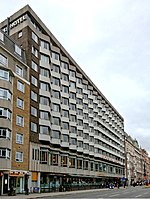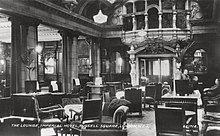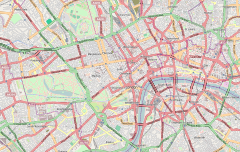Imperial Hotel, London
| Imperial Hotel | |
|---|---|
 Imperial Hotel, Russell Square, 2017 | |
| Hotel chain | Imperial London Hotels |
| General information | |
| Address | 61-66 Russell Square |
| Town or city | London, WC1B 5BB |
| Country | United Kingdom |
| Coordinates | 51°31′18″N 0°07′27″W / 51.5218°N 0.1241°W |
| Renovated | 2024-2026 |
| Technical details | |
| Floor count | 10 |
| Other information | |
| Number of rooms | 357 |
| Website | |
| www | |
The Imperial Hotel is a temporarily closed [1] hotel on the east side of Russell Square, a branch of Imperial London Hotels.[2] - a chain of budget tourist hotels with several properties in the Bloomsbury area.
Former building (1907-1967)
[edit]

The original building was designed by Charles Fitzroy Doll and built between 1905 and 1907. The height of the building was 61 meters and there were 15 floors.[3] In its opening year 1907 it was used by the first all Indian cricket team to tour England.[4]
Physicist Leo Szilard was staying at the Imperial Hotel when he conceived of the atomic bomb.[5]
Round about 1910 an extension to the hotel took place and construction was completed in 1913.[6] As part of the extension, Victorian-style Turkish baths were constructed.[7][8] The hotel had about 640 bedrooms.[9] The building was equally colossal as its neighbour the Kimpton Fitzroy London Hotel and the architectural style was a mixture of Art Nouveau Tudor and Art Nouveau Gothic, combining terra-cotta ornaments in which the corbels, gargoyles and statues were modelled with red brick. Towers rose above a high mansard roof of green copper. A Winter Garden occupied the ground floor between the two bedroom wings. Both Winter garden and Turkish baths were decorated in glazed Doulton ware.[10]
The building was demolished at the beginning of 1967.[3][11] It was demolished because of its lack of bathrooms and because, according to the Greater London Council, the whole frame of the building was structurally unsound. There was no possibility of saving it if a preservation order had been placed on the building. In truth, however, the building was probably a victim of fashion and the prevailing taste in the 1960s.[12] All that remains of the building are 21 statues from the Turkish baths, bells and a galleon, now placed in the courtyard of the current hotel.[13]
Current building
[edit]
The hotel was replaced by a new building of the same name.[14] The hotel is currently closed for renovations and will reopen in 2026. When it reopens, it will feature 357 rooms and a rooftop bar and restaurant. [15]
See also
[edit]References
[edit]- ^ London’s Imperial Hotel to undergo “once-in-a-generation” refurb
- ^ "Imperial London Hotels - Great Value Central London Hotel Rooms From £54 Per Night | Imperial Hotels". imperialhotels.co.uk. Retrieved 10 September 2016.
- ^ a b "Imperial Hotel, London | 1201988 | EMPORIS". Emporis. Archived from the original on 25 July 2020.
- ^ Alderman, Elgan. "Hundreds and heatwaves: the story of the 1911 All India tour to England that helped shape the country's identity". The Times. ISSN 0140-0460. Archived from the original on 29 November 2021. Retrieved 4 December 2021.
- ^ Lordan, Robert (4 January 2020). "Bloomsbury: Where The Bomb Was Born".
- ^ Getting Dolled Up On The East Side|Thelondonwanderer
- ^ "Turkish baths at Imperial Hotel". London Remembers.
- ^ Shifrin, Malcolm (2015). Victorian Turkish baths. Swindon: Historic England. pp.218—224
- ^ Vintage postcard from 1930s says:"640 bedrooms with hot & cold water, telephones, radio, central heating. Fully licensed""
- ^ Stamp, Gavin (2010). Lost Victorian Britain. London: Aurum Press Ltd. p. [page/59 61]. ISBN 9781845135324.
- ^ Baker, Roger (1968). The Book of London. London: Michael Joseph Ltd. p. [page 128].
- ^ Hobhouse, Hermione (1971). Lost London. London & Basingstoke: MacMillan London. p. [page 207].
- ^ "Imperial Hotel - statue 15". London Remembers.
- ^ Hobhouse, Hermione (1972). Lost London ([1st American ed.] ed.). Boston: Houghton Mifflin. p. 207. ISBN 9780395135211.
- ^ London's Imperial Hotel undergoing renovation
External links
[edit]- Hotels in London
- Demolished hotels in the United Kingdom
- Demolished buildings and structures in London
- Hotels established in 1911
- Hotel buildings completed in 1911
- Hotel buildings completed in 1967
- Buildings and structures demolished in 1966
- Buildings and structures in the London Borough of Camden
- Buildings and structures in Bloomsbury

